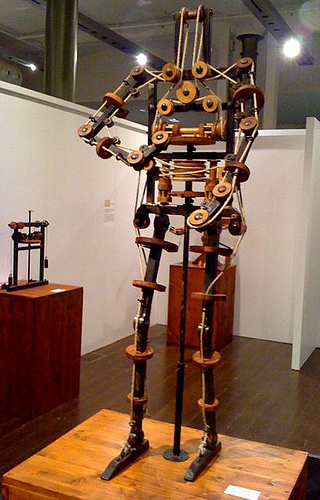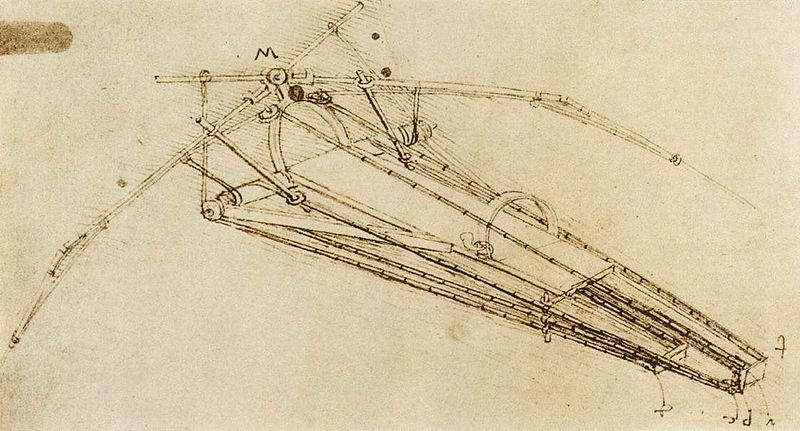Leonardo da Vinci Leonardo da Vinci was the greatest genius ever produced by mankind, ever. His designs have been put to the test in a television programme examination to see if they actually would work. But Leonardo covered his drawings with false leads to that people could not copy them. I am constructing the page as an on going project so it will change, in time. Some of this has been written by me and some copied from another site, and duly acknowledged. It seems silly to me to read an item, and then retype it in my own words when the original author has done such a good job. |
|
| Flight For example his glider is backwards and has a tail missing. But it was built correctly, and flew. When it was tested in a wind tunnel in Liverpool University, the aerodynamics were perfect, da Vinci had even calculated the vortices of the air causing the glider to generate its own lift. I think he could well have invented an aeroplane given the money and resources. When the parachute was actually built, and a deliberate design error was corrected, it worked perfectly. His glider also worked, again, when built in errors were corrected. https://www.youtube.com/watch?v=XC74ImdHaLQ Video of glider test |
  |
   |
Diving Suit
Another was his diving suit, built to his original specifications, using the same materials, and, once the design code had been cracked, tested. it worked. An experienced lady tested it on the seabed off Venice, the original place it was intended for use - and it worked and she could breath normally as she walked across the seabed. What made Leonardo da Vinci such a great artist
was also what made him such a great inventor: his fascination with the
world around him. This was the case with water. In his lifetime, da
Vinci designed many inventions dealing with water – perhaps, most
notably, scuba gear. While working in Venice, the "water city", in
1500, da Vinci designed his scuba gear for sneak attacks on enemy ships
from underwater. The leather diving suit was equipped with a bag-like
mask that went over the diver’s head. Attached to the mask around the
nose area were two cane tubes that led up to a cork diving bell floating
on the surface. Air was provided from the opening of the tubes
to the diver below. The mask also was equipped with a valve-operated
balloon that could be inflated or deflated, so the diver could more
easily surface or sink. Additionally, Leonardo da Vinci’s scuba gear
invention incorporated a pouch for the diver to urinate in. Da Vinci’s idea for Scuba gear (like many of his
invention ideas) didn’t actually become well-known until his famous
Codex Atlanticus, a twelve-volume set of his drawings and notes, was
published after his death. |
| Mechanical Man A mechanical man was designed by Leonardo and built by a NASA robotic scientist following the plans - it worked. By the use of pulleys and cable, for tendons, the armoured 'man' was sitting down and was able to stand up, using the exact means as that of a human. The centre of gravity was 'exact'! This was built as an exhibit at one of the Duke of Milan's parties. It was seated in a Grotto and when the guests mingled into the area, it was activated by either water or weights and stood up and moved its arms exactly as a human being would have done. |
  |
  |
Anatomy Leonardo also discovered that blood deposits (later known as cholestrol) was the cause of hardening of the arteries causing death in apparently healthy people. But, when he died, his work was stored away and forgotten for centuries. Now we can see that a lot of things we think are 'modern' inventions or discoveries, were already known to da Vinci. His anatomical drawings surpass much we have in books today, both in detail and explanation. |
|
War Although he hated war, he designed war machines. The tank was built by British Army engineers, and after discovering a deliberate flaw in the design, corrected it and the tank worked prefectly. He even designed the slope of the external case to deflect projectiles etc from causing damage, much like the armour on the Challenger Tank of today. He also did a drawing of a projectile which bears an uncanny resemblance to the modern armour piercing rounds on modern tank warfare. He wrote: “I can make armoured cars*, safe and unassailable, which will enter the close ranks of the enemy with their artillery, and no company of soldiers is so great that it will not break through them. And behind these the infantry will be able to follow quite unharmed and without any opposition.” * would da Vinci have actually said 'cars', or carriages?? |
 |
 |
Paintings His paintings are supposedly full of geometric designs, puzzles and secret signs. His famous mural Last Supper, which he completed for the Duke of Milan, shows a woman by his side, described by the Vatican as St Peter, but very definitely feminine. It is thought by many that this is a depiction of his wife, Mary Magdelene. And again, its full of ancient symbology. In his novel The da Vinci Code, Dan Brown tells us that the figure ion the right hand of Jesus is his wife, Mary Magdelene. Naturally this caused quite a stir when published, notably by religious personages who did not want their beloved beliefs flawed or scorned. But it does actually make sense. Mary was 'proclaimed' a whore 400 years after the event. I think this was mainly due to the fact that Jesus declared her his successor!! Chauvenists in the Church in Rome would have had heart attacks!! Many sites on this mural do not mention the possibility, prefering 'ostrich' politics and bury their heads in the sand. I do not KNOW, but I do believe it was entirely feasible. He would have been married, all Rabbi's were, and if he did teach in the Temple, he could only have done so as a Rabbi. da Vinci knew a lot more than he tells us, openly, and this painting, like the mona Lisa below, is full of codes and information. Both Mary, a noblemans daughter, and Jesus, of the house of David, were of royal blood. |
| The Mona Lisa is so full of visual codes, still
undeciphered. See also biography, below. This portrait was doubtless painted in Florence between 1503 and 1506. It is thought to be of Lisa Gherardini, wife of a Florentine cloth merchant named Francesco del Giocondo - hence the alternative title, La Gioconda. However, Leonardo seems to have taken the completed portrait to France rather than giving it to the person who commissioned it. It was eventually returned to Italy by Leonardo's student and heir Salai. It is not known how the painting came to be in François I's collection. The history of the Mona Lisa is shrouded in mystery. Among the aspects which remain unclear are the exact identity of the sitter, who commissioned the portrait, how long Leonardo worked on the painting, how long he kept it, and how it came to be in the French royal collection. (He kept it throughout his life - mk) The portrait may have been painted to mark one of two events - either when Francesco del Giocondo and his wife bought their own house in 1503, or when their second son, Andrea, was born in December 1502 after the death of a daughter in 1499. The delicate dark veil that covers Mona Lisa's hair is sometimes considered a mourning veil. In fact, such veils were commonly worn as a mark of virtue. Her clothing is unremarkable. Neither the yellow sleeves of her gown, nor her pleated gown, nor the scarf delicately draped round her shoulders are signs of aristocratic status. The above 3 parapgraphs can be found in the following site: http://www.louvre.fr/en/oeuvre-notices/mona-lisa-%E2%80%93-portrait-lisa-gherardini-wife-francesco-del-giocondo |
 |
 |
 Device for lifting water |
|
Biography - See link below Born out of wedlock, the love child of a
respected notary and a young peasant woman, he was raised by his father,
Ser Piero, and his stepmothers. At the age of 14, da Vinci began
apprenticing with the artist Verrocchio. For six years, he learned a
wide breadth of technical skills, including metalworking, leather arts,
carpentry, drawing and sculpting. By the age of 20, he had qualified as
a master artist in the Guild of Saint Luke and established his own
workshop. Florentine court records show that da Vinci was charged with
and acquitted of sodomy at the age of 22, and for two years, his
whereabouts went entirely undocumented. In 1482, Lorenzo de' Medici, a man from a
prominent Italian family, commissioned da Vinci to create a silver lyre
and bring it to Ludovico il Moro, the Duke of Milan, as a gesture of
peace. Da Vinci did so and then wrote Ludovico a letter describing how
his engineering and artistic talents would be of great service to
Ludovico's court. His letter successfully endeared him to Ludovico, and
from 1482 until 1499, Leonardo was commissioned to work on a great many
projects. It was during this time that da Vinci painted "The Last
Supper."Da Vinci's most well-known painting, and arguably the most
famous painting in the world, the "Mona Lisa," was a privately
commissioned work and was completed sometime between 1505 and 1507. Of
the painting's wide appeal, James Beck, an art historian at Columbia
University, once explained, "It is the inherent spirituality of the
human creature that Leonardo was able to ingenuine to the picture that
raises the human figure to some kind of majesty." It's been said that the Mona Lisa had jaundice,
that she was a pregnant woman and that she wasn't actually a woman at
all, but a man in drag. Based on accounts from an early biographer,
however, the "Mona Lisa" is a picture of Lisa Gioconda, the real-life
wife of a merchant, but that's far from certain (but almost certainly is
accurate - mk) . For da Vinci, the "Mona Lisa" was forever a work in
progress, as it was his attempt at perfection. The painting was never
delivered to its commissioner; da Vinci kept it with him until the end
of his life. Today, the "Mona Lisa" hangs in the Louvre Museum in Paris,
France, secured behind bulletproof glass, and is regarded as a priceless
national treasure. The above, and more, can be read on the
following url: Which also contains an excellent video film of his life.http://www.biography.com/people/leonardo-da-vinci-40396 |
 Flying Machine |
 very clever, reads the same upside down and reversed  |
He was also thought to have been head of one of the most secret of organisations that may, or may not, have existed, The Illuminati. Many scholars think it still exists today and that some recent Presidents of the USA were members. Another head of this organisation, in a different time, was Sir Isaac Newton. (allegedly, as we have no proof). Many will make much out of little and I simply, do not know! In da Vinci's works he is making his work laugh at the authorities of the day by leaving clever messages for the future. He needed money to continue his work so he was employed by some very dangerous liaisons. The evil Duke of Milan, The Borgias, to name but two. |